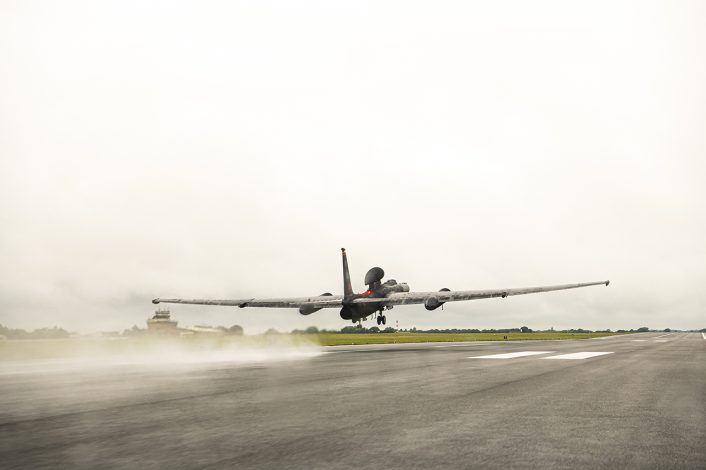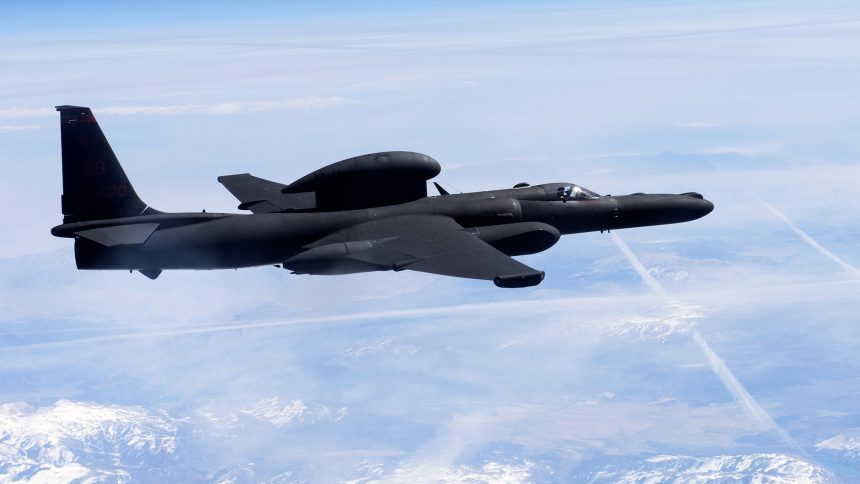Flying from Beale AFB, a Lockheed U-2 aircraft, using the specially chosen callsign DRAGON 70, was heard communicating with ATC about a plan to set an endurance and altitude record for the ‘category and class’ of aircraft.
Aviation enthusiasts were able to record the pilot of DRAGON 70 communicating with the Atlanta Air Route Traffic Control Center (ARTCC) in which he stated that the aircraft had departed from their Californian base at 9:30pm the previous evening, intending to return the following afternoon.
Towards the end of the sortie, he said he aimed to take the aircraft to a higher altitude and claim a new record for the aircraft. This would coincide with the aircraft being at the lightest possible weight, allowing for maximum altitude performance. Though a record was broken, we don’t know what the old record was, nor what the new record is.
DRAGON 70 (U-2) wkg ATLANTA CENTER on UHF explaining they are trying to set an endurance and altitude for category and class of aircraft. 😎
OTD 70 years ago, Anthony LeVier made the first flight of the Lockheed U-2 at Groom Lake on August 1st, 1955.
It’s too bad their ADSB is… pic.twitter.com/cvF0BHWiWA
— Thenewarea51 (@thenewarea51) August 1, 2025
Despite the aircraft’s age, the Lockheed U-2 Dragon Lady’s exact altitude performance remains classified. Civilians who have been offered backseat rides in the twin-seat TU-2S aircraft, like Adam Savage, have remarked that although they know the exact altitude that they had reached on their flight they are not able to disclose anything other than ‘above 70,000 feet’.
The U-2’s record breaking flight was organised to mark the aircraft type’s 70th anniversary of flight. The first U-2 test flight, on Aug. 1, 1955, was accidental. During a planned high speed taxi test, the prototype U-2, known as Article 341, lifted from Groom Lake – commonly known as Area 51 – at only 70 knots. Test pilot Tony LeVier soon discovered the U-2’s infamous difficult landing process for the very first time, slightly damaging the airframe when attempting to bring it back onto the ground.
This anniversary has been noted during many of the U-2’s public appearances during 2025, especially at the Royal International Air Tattoo (RIAT) at RAF Fairford, UK, and at EAA AirVenture Oshkosh in Wisconsin. At the former, a U-2 forward deployed to the base with the 99th Expeditionary Reconnaissance Squadron performed a flying display while carrying operational mission equipment like the dorsal satellite datalink pod, either ‘Senior Span’ or ‘Senior Spur’ depending on mission requirements.
Without a doubt our @airtattoo highlight from today was the USAF U-2S spy plane in Senior Span mission configuration as part of the flying display. Long may the Dragon Lady reign over RAF Fairford 🐉#AvGeek #RadioGeek #RIAT25 pic.twitter.com/XzmuidKPXZ
— Military Monitoring World (@MilMonWorld) July 19, 2025
DRAGON 70 was not transmitting on the right transponder modes for flight tracking websites like Flightradar24 to display its flight path, though even if it was it likely would give us no further information regarding the aircraft’s altitude. To help protect information about the U-2’s capabilities and its operations, the altitude reporting function within the aircraft’s transponder is usually configured to ‘max out’ at 60,000 feet.
Here are some photographs taken from U-2 pilot and friend who took @TheAviationist patch to 70K feet (69,068 ft actually based on the altimeter…) in a Dragon Lady recently. No better way to celebrate Skunk Works 75th anniversary! pic.twitter.com/OQGv7TQKWu
— David Cenciotti (@cencio4) June 14, 2018
When communicating with civilian air traffic control, U-2 pilots will request clearance to above 60,000 feet only, without referring to specific altitudes. Codewords are used to communicate exact altitudes with military air traffic control without revealing the information to anyone who might be listening in.
Future of the U-2
The Dragon Lady was due to retire from the U.S. Air Force in 2026, and some aircraft have already been withdrawn ahead of this date. However, as has happened previously, the aircraft’s sundown date is a subject of intense scrutiny by Congress and we may well see the type continue to operate beyond this date. Notably, U-2s are still engaged in active intelligence, surveillance, and reconnaissance (ISR) missions on a daily basis from forward operating locations, and these show little sign of slowing down.

While many of the U-2’s original functions are now covered by satellites, the ability to rapidly reconfigure U-2 airframes with different sensor payloads and task the aircraft to different locations in real time mean there is still significant utility to be gained from its use.
Unmanned aircraft can take some of this burden, and indeed there are plans for unmanned aircraft to begin operating from RAF Fairford in the near future. However, the RQ-4 Global Hawk, which is the closest unmanned alternative to the U-2, has a smaller payload than its manned competitor.
The RQ-4 itself is due to be withdrawn in the years to come, being succeeded by more capable aircraft like the classified and provisionally named ‘RQ-180’, but remains in frequent operational service likely due to lower operational costs and the more flexible basing allowed by a publicly acknowledged aircraft type.









